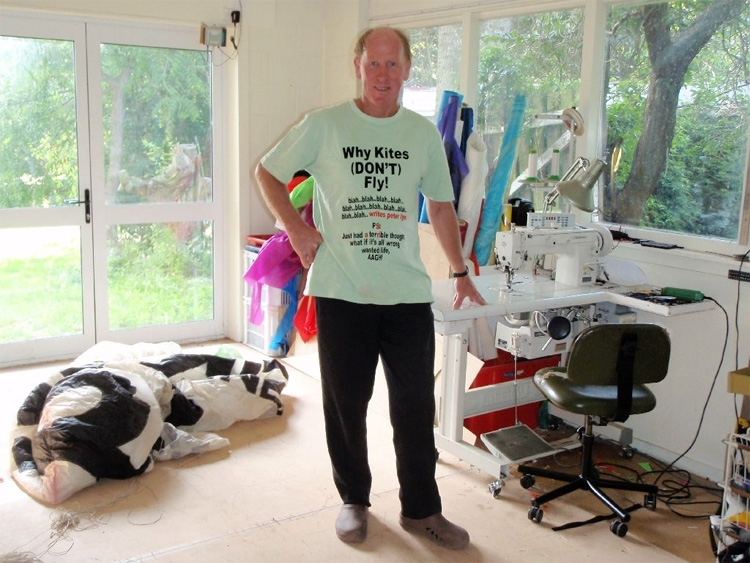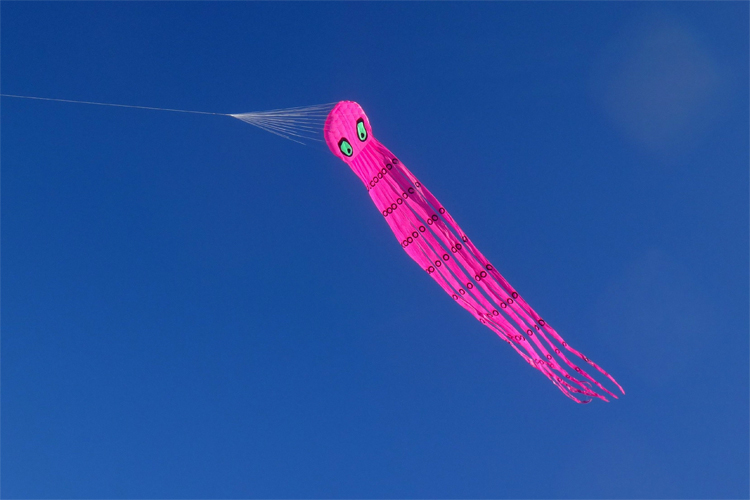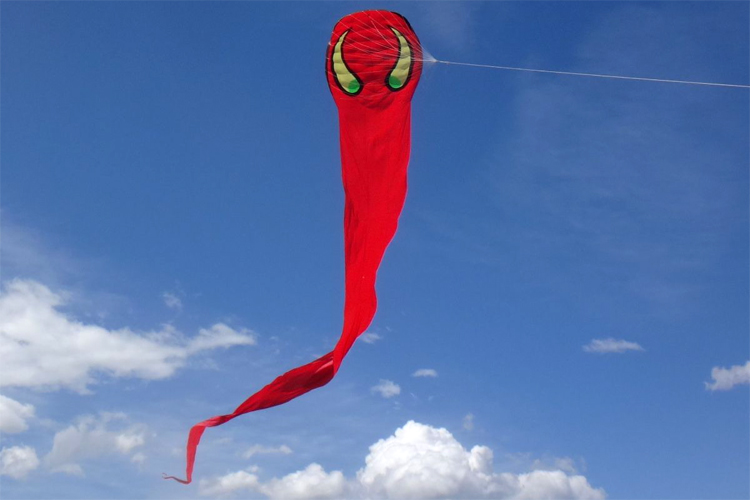In 2013, I began developing single-skin, single-line kites. They were reliable enough in a range of winds to be useful as pilot and show kites at kite events but didn't have sticks, inflated tubes, or ram-air inflated spaces.
It hadn't been done yet; it was probably possible, and it was a project I thought myself well suited to by resources and experience - somewhat hubristically, as it's turned out.
I've now put some thousands of hours into this, and it's time for an accounting as to where things are at. Not much progress.
Certainly not enough to justify the time and resources applied.
I've been a magnet for lost causes: kite sailing, another developmental field I've put inordinate effort into, has sucked up a fair portion of many people's lives without achieving commercial success - though the spin-offs of kite buggying, kitesurfing, foil boarding, and snowkiting have been paybacks.
And yet another field I've been involved with - Stirling cycle engines (named after the Reverend Doctor Robert Stirling, whose first patent in the field dates to 1817) is similarly afflicted.
Stirling engines have had billions of dollars (yes, really) spent on them by thousands of deluded engineers but have so far only found minor niches such as desktop toys and as a marginally effective alternative to nuclear power for submarines.
Oh, and in my spare time, I've become a sawmiller, operating the ex-Hoberg family (Volker Hoberg is one of the infamous No Limits kite team from Germany) vintage reciprocating sawmill which I brought to New Zealand ten years ago and have now rebuilt.
It cuts wonderful big slabs of exotic and special timbers for artisan furniture makers and woodturners but takes as long as 45 minutes to make a cut that a modern band mill can do in 15 or 20 seconds.
But back to the single-skin (lack of) progress report.
Last week, I had a reality check.
At this year's Nelson Kite Festival (number 29), the wind was so strong and turbulent that no maxi kites were flown until very late in the day, by which time I'd left to come back to Ashburton.
Flying Single-Skin Pilot Kites
I tried flying some single-skin pilot kites.
Most of these were of the 1Skin style, which has been intensively developed through 50 or more prototypes and can be very useful in low-to-mid-range winds because of their excellent lift, high-flying angle, and low cost.
"Out of the bag," none would stay up. In the strong, gusty winds, they sooner or later dived off unrecoverably to one side or the other.
This was neither a surprise nor a new problem, but I had thought it would have yielded to accurate construction and relentless iterative development by now.
It hasn't. But then again, as the ditty says, "any problem worth attack will prove its worth by fighting back," and this is exactly what I signed on for.

Taking a step back, "diving over" almost certainly has as its fundamental cause that the "structure" of single-skin kites (fabric), is unable to resist compression loads - any compressive load anywhere and they buckle.
This can be seen when conventional parachutes are towed behind boats as parasails. To gain height, the bridles on the side nearest the boat (called the leading edge) are pulled in a bit.
This enables the parachute (and person) to rise to not much more than 30 degrees before the leading edge gets pushed in.
When the pressure of the air pushing on the outside is higher than the pressure "captured" inside the parachute, the fabric buckles because it cannot resist compressive loads.
But to be useful, single-skin kites need to fly at a line angle higher than 30 degrees - and this is the single-skin kite challenge.
1Skins are shaped like an aircraft wing, except their lower skin extends only a short distance back from the leading edge - typically 5-to-10 percent of chord.
This is aerodynamically efficient (that is, it enables the kite to fly at a high line angle) and is the form used for high-performance, single-skin traction kites.
But at high-flying line angles, wind pressure buckles this type of leading edge inwards - which single-skin traction kites typically counter with stiffening rods (weed-whacker cord or flexible carbon fiber rod).
For single-line versions, I'm restricting myself to what can be achieved without stiffening of any kind - with some thoughts that this might then feedback to single-skin traction kites and kite sailing.
For 1Skins, when the leading-edge buckles in asymmetrically, which it always does sooner or later as wind speed increases, the kite dives off to one side.
A second effect is that the wind pressure pushing on the leading edge can buckle the fabric further back along the kite's skin - which has the same result.
Upsides, Downsides
But there is a form of leading edge that is more resistant to crumpling - and better able to pop out again when it does.
This is the bridle-supported leading edge used on the Octopus and Serpent-style single-skin show kites I've also been developing.
The Octopus (not to be confused with the ram-air Octopus from 1990) was my (?) first successful single-skin show kite design: successful as in flying reliably in a (very) wide wind range.
They fly at a high line angle and don't suffer from the 1Skin's "diving over," but have a problem which at first didn't seem serious: to fly satisfactorily, their tentacles must be cross-linked with multiple cords.
These provide necessary extra drag and stop the tentacles from tangling into big balls that take hours to untangle.
I've not found any other way to stop this tangling, but these cross-links snag on things, damaging the kite and posing a danger to everything in the vicinity.
An alternative form that doesn't have this problem is the Serpent, but these have a slightly narrower wind range because their single tail is heavier and doesn't have as much drag.
They're improving at every iteration, though (taking lessons from the Balinese Janggans) and, at less than 10 km/h to more than 50 km/h, are adequate for general kite festival flying.
It's especially satisfying that the 60-meter version flies at least as well as the 20-meter it was scaled from while being four times as big by area.
Fabric stiffness is not, therefore, a factor - a goal achieved.

Developments With General Applications
Supporting this design are two developments that have general applications for single-skin kites and, indeed, for many ram-air inflated show kites.
The first is a bungy and pulley mechanism that automatically lets out some or all of the leading-edge bridles as wind speed increases to prevent leading-edge collapse and extend the kite's wind range without having to change bridle settings.
The other is "aeolian" bridling. This is the use of braids rather than cords for a kite's rear bridles.
When flying at high line angles, braids of suitable length, width, and weight flutter harmonically, which causes their drag to increase rapidly.
By doing this, they pull down on the rear of the kite when the wind is stronger, offsetting extra nose-down bridling that enables lighter wind flying.
The result is a kite with a broader wind range.
A worthwhile feature is that when the flying line is horizontal, braid bridles lie in the wind direction, so don't apply much if any extra pull to the rear of the kite.
This reduces stalling and makes launching easier.
But when the kite is flying high in strong winds, they hang transverse to the airflow in full vibratory mode - applying 10 to 20 kgs of extra pull to the rear bridle points (in the case of a 60-meter Serpent), which prevents overflying and reduces leading-edge collapse.
So, single-skin, single-line pilot kites are limited to light wind use at present, but there is now a single-skin, single-line show kite that can hold its own at any kite event.
Will single-skin pilots ever seriously challenge ram-air inflated styles for general use?
Two reasons to think they may.
Bridle-supported leading edges from the Octopus/Serpent style can be grafted onto 1Skin style kites, which will address one of its problems (though there may be a few others lurking there too).
And, quite a few other kite fliers are engaged in this development now - their fresh thinking can only be helpful.
Making an all winds, tailless, single-skin, single-line kite remains a formidable challenge.
But it is far from being a lost cause.
Words by Peter Lynn | Founder of Peter Lynn Kites
